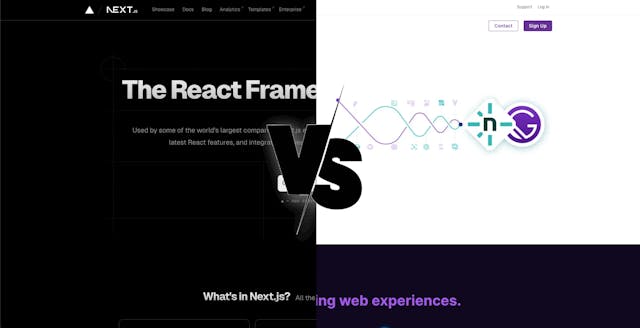Enhancing SEO in Next.js Applications: Techniques and Tools

Enhancing Search Engine Optimization (SEO) in Next.js applications involves a comprehensive approach, focusing on optimizing various elements from media files like images and videos to more technical aspects such as scripts, metadata, and static assets. By implementing these techniques, developers can improve their site's visibility, user experience, and ultimately, its ranking in search engine results.
External tools
Once your Next.js site is developed and ready for review, it's crucial to evaluate its performance and SEO effectiveness using various testing tools. Tools such as Ahrefs, Google PageSpeed Insights, and UnLighthouse offer detailed insights into how your site performs in real-world conditions.
Ahrefs can help identify SEO issues, track rankings, and provide keyword insights, making it invaluable for understanding your site's visibility on search engines. Google PageSpeed Insights offers actionable advice on how to improve website speed and user experience, directly impacting your SEO rankings and user retention.
UnLighthouse, as detailed in this article, takes it a step further by allowing you to scan your entire site, not just individual pages. This is particularly beneficial for catching widespread issues and ensuring consistency across your site. These tools can highlight areas for improvement in accessibility (WCAG), SEO, performance, and more, guiding you towards a more optimized and user-friendly website. By understanding what is wrong, you can make informed decisions to enhance your site's overall SEO strategy and user experience.
Optimizing Media for Enhanced SEO
Images
Images can significantly impact your Next.js application's SEO and performance. Optimize images using Next.js's built-in Image component, which provides automatic resizing, optimization, and serving in modern formats like WebP.
js
Remember to use descriptive alt text for accessibility and additional SEO benefits.
Fonts
Optimize font usage by limiting the number of font weights and styles, and use modern font formats. Next.js allows you to customize the Document (in layout.js or layout.tsx) to preload fonts for improved performance.
ts
Improving SEO with Metadata and Scripts
Metadata
Effective use of metadata can significantly impact your Next.js app's SEO. Utilize file-based metadata like favicon.ico, apple-icon.jpg, opengraph-image.jpg, and twitter-image.jpg to enhance your website's appearance in search results and on social media.
Additionally, include meta tags for SEO in your pages or in a custom _document.js:
js
Scripts
Optimize the loading of third-party scripts using the next/script tag with the strategy attribute set to lazyOnload. This ensures scripts do not block the main thread, improving performance and SEO.
js
Bundle Analyzer
Use Next.js's Bundle Analyzer to identify and eliminate unnecessary JavaScript from your bundle, reducing load times and improving SEO.
To set up Bundle Analyzer, update your next.config.js:
js
Then, analyze your bundle by running ANALYZE=true next build.
Leveraging Lazy Loading and Static Assets
Lazy Loading
Implement lazy loading for images, iframes, and components to improve initial load time, which is crucial for SEO. Next.js's Image component and dynamic imports with React.lazy are powerful tools for this purpose.
js
Static Assets
Utilize the static folder for assets that do not need to be optimized by Next.js, such as robots.txt and sitemap.xml. These files can be accessed directly and help improve your SEO by guiding search engine crawlers.
Remember to continuously monitor your Next.js application's SEO performance using tools like Google PageSpeed Insights, Ahrefs, or UnLighthouse. Iteratively apply these techniques and tools to ensure your application is as optimized as possible for search engines.
Sitemap
js
Robots.txt
js
Advanced SEO Techniques and Analytics Integration
Analytics
Proper integration of analytics tools is crucial for understanding user behavior and improving SEO. However, it's important to ensure that these tools do not negatively impact your site's performance. In Next.js, use the next/script tag for non-blocking loading of analytics scripts:
js
Replace 'GA_MEASUREMENT_ID' with your actual Google Analytics measurement ID. This approach ensures that the analytics script does not interfere with the initial page load.
Instrumentation and OpenTelemetry
For more sophisticated SEO and performance analysis, consider implementing instrumentation with OpenTelemetry. This open-source framework provides APIs and libraries to collect and export telemetry data (metrics, logs, and traces) to analyze the performance of your Next.js application.
Integration of OpenTelemetry into your Next.js project can help identify bottlenecks and areas for improvement, but it requires a more advanced setup and is typically used in larger or more complex applications.
Implementing SEO-Friendly RSS Feeds
Creating an RSS feed for your Next.js application can improve SEO by facilitating content syndication and providing backlinks to your site. Here's an example of how to implement an RSS feed in Next.js:
js
This script generates an RSS feed from a list of blog posts. Modify getLatestBlogs to match your application's method of retrieving blog data.
Generating Dynamic Metadata for Enhanced SEO
Use Next.js to dynamically generate metadata for each page, improving your site's SEO by ensuring that each page is accurately described and categorized. Here's an example helper function for generating page-specific SEO metadata:
js
Then, use this function in your Next.js pages to inject SEO metadata into the <Head> component:
js
By tailoring the metadata for each page, you enhance the relevance and reach of your content in search engine results, contributing positively to your site's overall SEO.
Remember, SEO is not a one-time task but a continuous process of optimization and improvement. By integrating these SEO techniques into your Next.js application, you're setting a solid foundation for improved search engine visibility and user engagement.
Utilizing Next.js's Built-in Features for SEO
Next.js offers several built-in features that can enhance your application's SEO. Leveraging these can significantly improve your site's visibility and search engine ranking.
Dynamic Routes and Redirects
Next.js supports dynamic routes and redirects, which can be used to manage your site structure and URLs effectively—a crucial aspect of SEO. Properly structuring your URLs and handling redirects can prevent duplicate content and improve the user experience.
js
Optimizing for Mobile and Core Web Vitals
Mobile optimization and Core Web Vitals are increasingly important factors in SEO. Next.js provides tools and best practices to ensure your application performs well on mobile devices and meets Google's Core Web Vitals standards.
- Use responsive design practices and test your application on various devices.
- Optimize your images and assets to load quickly and efficiently.
- Utilize Next.js's built-in performance optimizations, such as automatic image optimization, lazy loading, and script minimization.
Integrating Web Analytics for Continuous Improvement
Finally, integrating web analytics into your Next.js application is crucial for tracking your SEO performance and identifying areas for improvement.
- Use tools like Google Analytics, Google Search Console, and other SEO analytics platforms to monitor your site's traffic, rankings, and user behavior.
- Regularly review your analytics data to understand how users are interacting with your site and which pages are performing well or poorly in search engine results.
- Make data-driven decisions to continuously optimize your Next.js application for better SEO performance.
Resorces
Conclusion
Improving the SEO of your Next.js application is a multifaceted process that involves optimizing media, leveraging metadata, enhancing site performance, and utilizing Next.js's built-in features. By following the strategies outlined in this guide, you can significantly enhance your site's search engine visibility, user experience, and overall performance.
Remember, SEO is an ongoing process that requires regular monitoring, analysis, and adjustment. Stay updated with the latest SEO best practices and continuously refine your Next.js application to ensure it meets the highest standards of search engine optimization.

